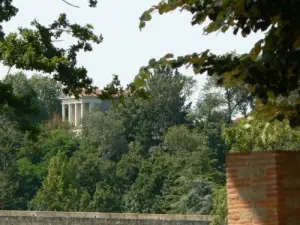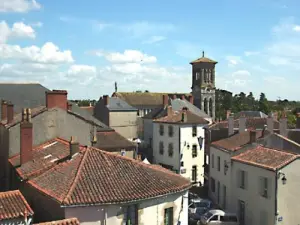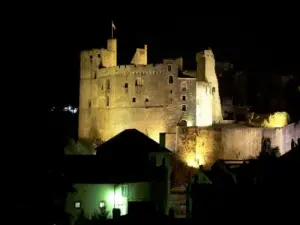On the banks of the Sèvre Nantaise, Clisson in Loire-Atlantique instantly charms walkers with its medieval air and Tuscan influence. Standing on a rocky promontory, its medieval character is clearly recognisable in its cobbled and sloping streets, the remains of the castle, a former fortress flanked by towers built between the 11th and 17th centuries, the bridges, the Romanesque church and the magnificent 15th-century covered market. The whole town is embellished by Italian architecture represented by tile and brick villas, Classical statues, arcades... Pay a visit to the Garenne Lemot estate on the banks of the Sèvre Nantaise, where you can stroll through the superb park and admire a typical Tuscan-style villa. Walk up one of the town's flights of steps to enjoy a lovely view over the tiled rooftops.
In the capital of the Nantes vineyard, the winegrowers of Clisson open their cellars to visitors for tastings that are a wine-lover's delight.
In June, the city hosts famous events such as the Montmartre art festival in Clisson and the Hellfest metal music festival, where the huge 10-metre-tall guitar is a curiosity in itself!
40 minutes from Nantes, a few kilometers from the banks of the Loire, Clisson is located in the heart of the Nantes vineyard, at the crossroads of Loire-Atlantique, Vendée and Anjou. Land nourished by the Sèvre and the Maine, two rivers which give its character to the Muscadet of the same name, the Clisson valley reveals itself as Italian and Breton when we talk about its heritage. Historic city with a unique character where tiles and bricks mingle with slate and granite. Landscapes of vines, villages of winegrowers with welcoming cellars…Clisson lives to the rhythm of the pleasures of the vineyard where Muscadet predominates.
History: At the crossroads of three ancient provinces, Anjou, Poitou, Brittany, Clisson has a fascinating history which takes us back in time to around the 11th century. The very prosperous period of the Middle Ages and its belonging to the Duchy of Brittany still mark many buildings. Illustrious people have inhabited the imposing castle of Clisson such as Olivier V the Constable or François II, father of Anne of Brittany... During the Vendée wars, at the end of the 18th century, the valley suffered the full brunt of the violence of the fighting. The reconstruction of the city will then take place in a very unprecedented way. The Cacault brothers (Pierre the painter and François the diplomat) will first create with a large private collection, a School Museum, which will be open from 1805 to 1810. The goal: to make the masterpieces of the 'art. The museum will not survive them and the collection will be purchased by the city of Nantes. Just before its opening, in June 1805, several renowned artists were invited there, including. FF Lemot, a sculptor, private advisor to Napoleon. Struck by the character of the city's large landscape, which reminded him of Italy, he decided to set up his future retirement in a park: La Garenne, nearby, in Gétigné. He also acquired the surrounding hillsides and the castle. From this point of view which dominates the city and the banks of the Sèvre Nantaise, he will then reconstruct the site like a historical landscape painting. A designer by training, he draws his inspiration from the sites of Switzerland and Italy, including the very spectacular city of Tivoli; near Rome. He also has as a reference the great masters of landscape painting (Poussin, Dughet, Lorrain). His project also follows to the letter the treatise "Les Éléments de perspectives" by Pierre Henri de Valenciennes, published in 1810. In parallel with this Italy dreamed of by Clisson, a new architectural style was born here: the rustic Italian style. It made it possible to rebuild the region quickly and unitarily with the architecture of the farms of central Italy. Today, this is the decor of tiles and bricks offered by Clisson and the entire Nantes vineyard.
The city has many historical monuments and listed sites and it is the most important heritage site in the Land of Art and History of the Nantes vineyard. It is classified as a green station, listed in the guide to the most beautiful detours in France and the Michelin green guide. You will find a tourist information office associated with a Muscadet cellar and a souvenir shop in the historic center, Place du Minage near Les Halles.































































